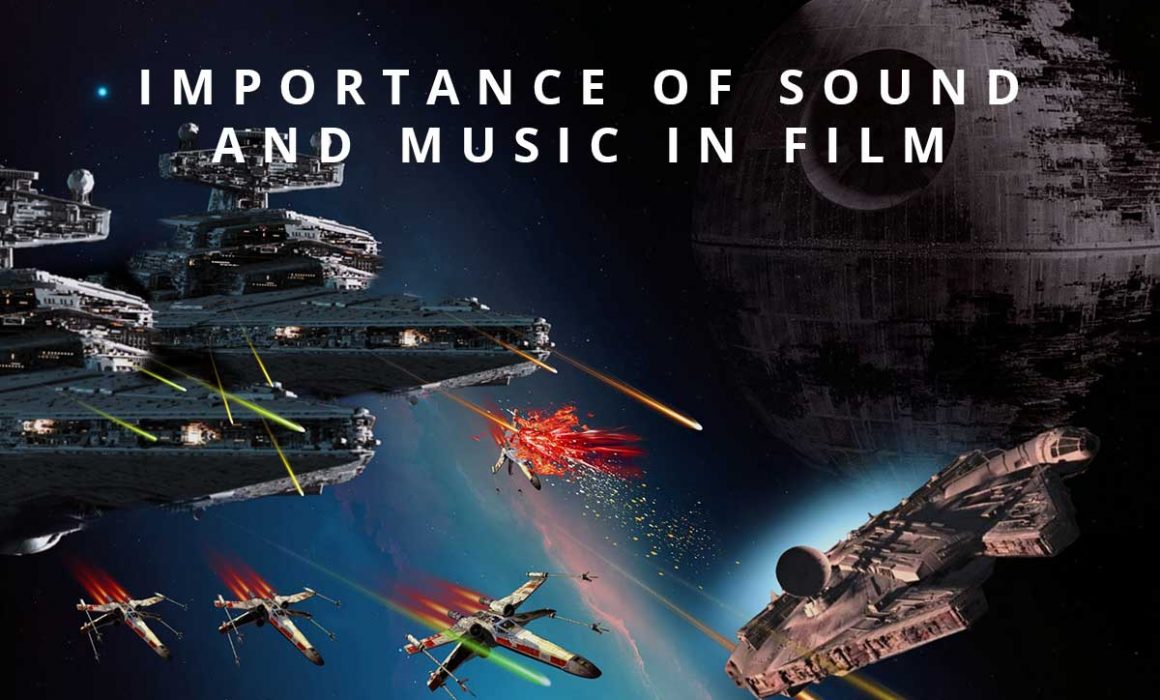Importance of sound and music in film
Sound and music play an essential part in building the story in films, be it a Hollywood Blockbuster or your own home videos. Here’s a breakdown of the types of sound used in movies to add to the story.
“The sound and music are 50% of the entertainment in a movie”
George Lucas
George is dead right, sound and music are a huge part of creating a movie, be it a big screen blockbuster or your own home videos, and it’s the reason he hires John Williams to score the music and Ben Burt for sound design in his films.
Here’s the Imperial March from Star Wars – I don’t know about you but it gives me shivers! Having attended live orchestral performances I can tell you the effect of the music doubled when you’re sitting in the audience watching it live (and I can only imagine what it’s like when you’re in the middle of the orchestra).
A lot of the impact of music is provided by the context in film, for example I’ve used this same track (the BBC version) in a family video! Yes, as a fun nod to a small boy’s obsession with Star Wars, this fitted the narrative perfectly. What else would one play when a kid is waving a lightsaber? Ok so there are much nicer characters in the movie than Darth Vader, but for sheer recognition you con’t go past this piece of music, and within a boy’s coming of age story, it fitted perfectly (and without the sinister overtones).
But there’s a lot more to be said about sound in movies than just the music! Sound designer Ben Burt is a bit of a hero of mine too, he designed some of the most memorable (and copied) sounds in movie history, in my humble opinion.
If you’re not sure what I mean by ‘sound design’, take a look at this clip from Star Wars – A New Hope. Listen to all the sounds – spaceship hums, boulders, the beeps of equipment. There’s no music at all until you reach 1:17 in the clip – notice how the music comes in just at the point where Obi-Wan (Alec Guiness) realises what the Death Star really is. ‘That’s no moon, it’s a space station’. Notice how adding the music right at this point heightens the suspense and drama of the scene.
That’s no accident, it’s a film technique!
Thalia Kemp
Another example, this is montage of Star Wars explosions. Notice all the additional sounds of the spaceships, squeaks, hums, zooms and whooshes among other things. Now turn the sound down – see how it’s lost all its energy? The dramatic effect is an equal combination of the vision, sound and music. I wondered if Ben Burt would come up with more sound innovations in the newer films, and he didn’t disappoint. Check out the explosion at 1:58, since copied many times by other filmmakers. He’s still the best!
Sonic Eye edit all our movies with sound, even family and home video footage. The sound is what brings it to life, along with good editing and the right music soundtrack. In videos where the sound is bad (particularly in outdoor footage where there is a lot of wind noise, GoPro and handicam footage), we take small sections of the original sound and mix it with sound samples to improve the overall effect.
Strictly speaking, this is sound editing, not sound design which includes creating and recording the sounds from scratch. This is different again from what’s called ‘Foley’, which is recording a sound to fit action on screen like footsteps, the sound of a vehicle, or ambience – the sound of a particular place or location. I use a little of all these techniques in my editing, which is why I describe myself as a sound designer as well as sound editor.
In all these examples the sound has been invented, designed (created) and added in under the dialog. In a more ‘normal’ setting, some of the original sound may have been kept but often in film, it’s all sound which has been recorded under ideal conditions, then added in later – even parks, street sounds, forest sounds, city sounds. That is why it’s always easy hear what people say in films, but not in real life! The other reason of course, is that people tend to speak over the top of each other in reality, not wait for the next person to deliver their line!
Here’s a summary of the types of sound used in film:
- Dialog – this should always be the most prominent, clear sound element so you can follow the story.
- Foley – this is the incidental sounds like footsteps, a car door clicking shut, that type of thing, which make the scene believable.
- Sound Effects – can be anything from explosions & glass shattering, to whooshes added to create drama.
- Ambience – sometimes called ‘atmos’ meaning ‘atmosphere’, this is the background sound of a particular location.
- Music – of course!
If you want your videos edited with sound design as well as with music, contact us to find out how we work. We make travel videos, family videos and more.
Thalia Kemp is the lead editor at Sonic Eye video and sound editing service, Sydney.
Image by ParallelVision from Pixabay

